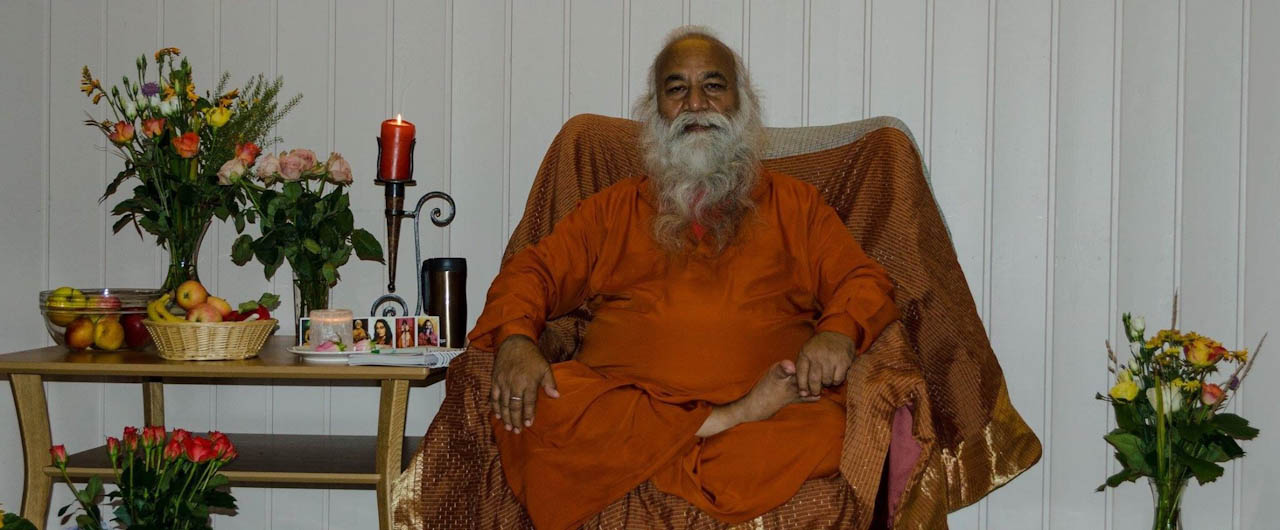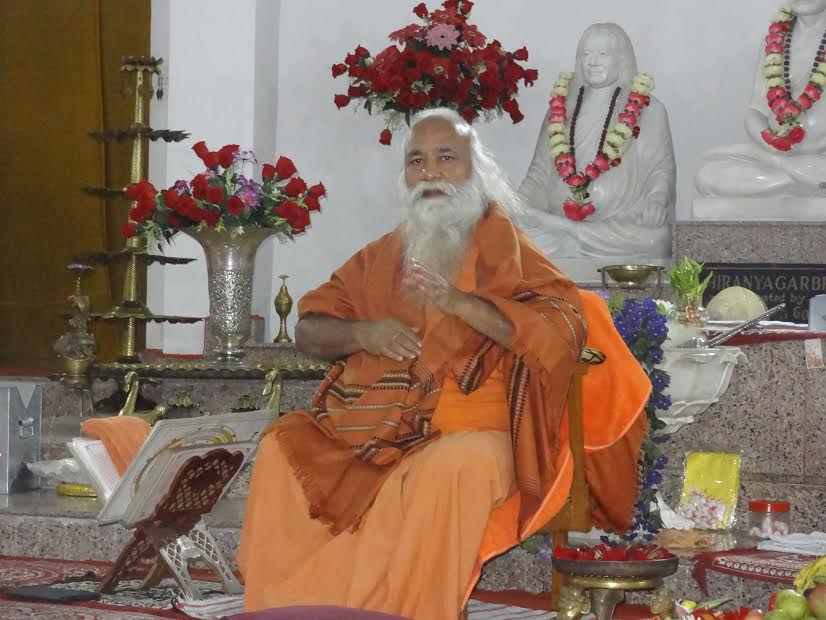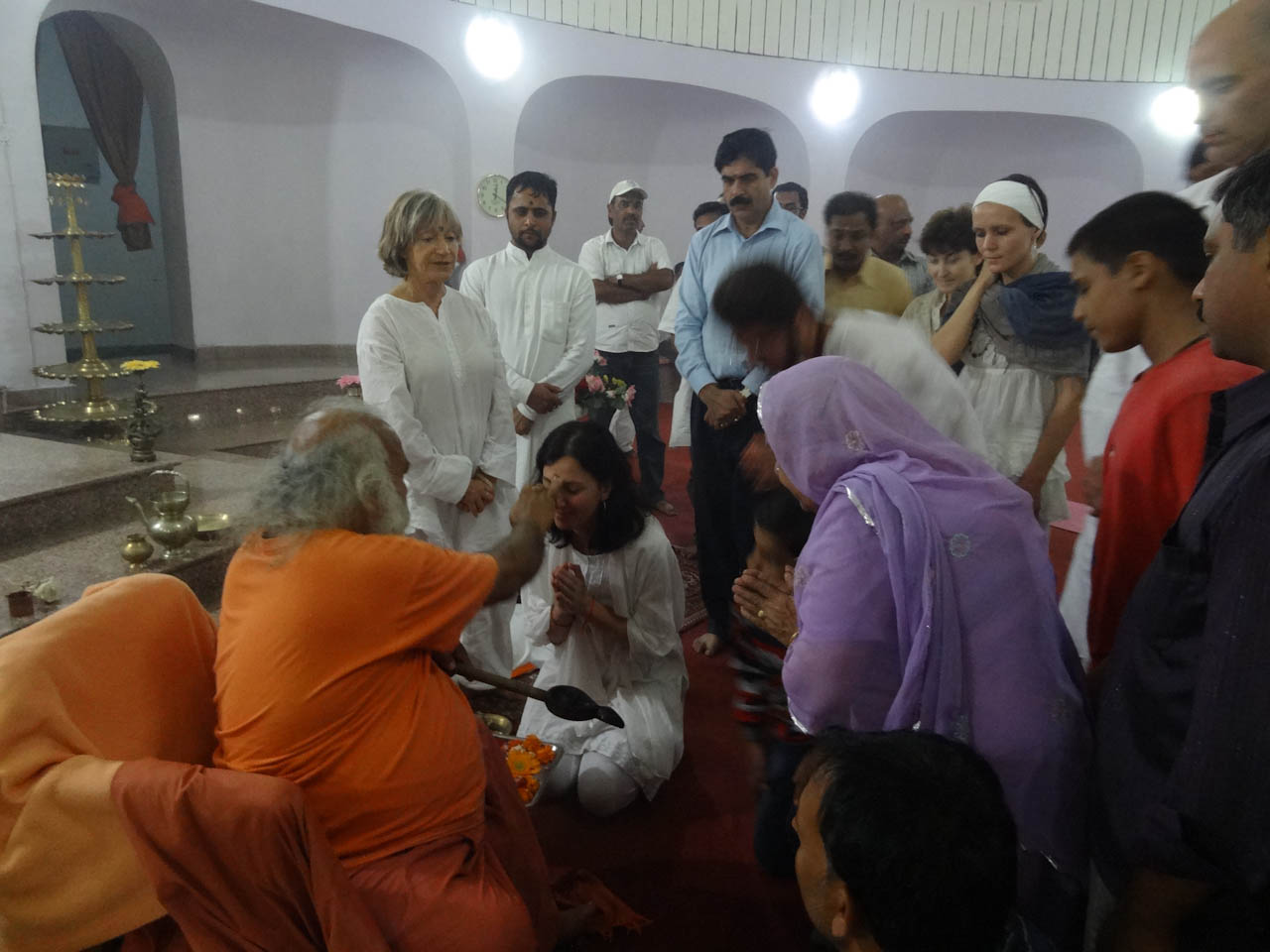
The science of Kriya Yoga
Kriya yoga is an ancient meditation technique which been brought back to us in 1861 with Mahavatar Babaji and has been handed down to the current Kriya lineage of masters directly through the master-disciple method of teaching. Kriya is a direct experience of the intimate connection between you and your breath. That experience can take one into the highest realisation as a Human Being, the Discovery of Unity in Diversity through Love, revealing the creativity which transcend the limitations of the mind and makes us co creators with God.
The science of Kriya Yoga
Becoming aware of what you are at the soul level and transcending even that into a deeper Reality ofthe Self is the ancient method of Kriya Yoga using the breath. This method is available for anyone who has a desire to start on a spiritual path. It is easy to learn and can be practiced anytime. Kriya is kept secret and the permission to teach is given after many years of practice. In this way, the Masters of this tradition kept the techniques unchanged to make sure that the dedicated practitioners would achieve the highest goals of Realization.
About my master: Swami Shankarananda Giri
Swami Shankarananda Giri is a spiritual heir in this tradition, and teaches these techniques in its original form as they were transmitted by the lineage of masters. Swami Shankarananda Giri has been teaching Kriya Yoga techniques in India since 1974, and in Europe since 1978. He has also inherited the astrological system called Cosmic Astrology from one of his masters, Swami Narayana Giri ("Prabhujee").
The other beloved master was Swami Paramahamsa Hariharananda. Booth of hismasters were direct disciples of Shri Yukteswar.
In the direct linage of Baba JI

About my Master’s Masters: The Lineage
Kriya Yoga has been passed directly from master to disciple: from Babaji Maharaj to Lahiri Mahasaya and after that Swami Shri Yukteshwarji to Paramahamsa Yogananda who wrote in 1946 his best selling spiritual classic, "Autobiography of a Yogi".In addition to Paramahansa Yogananda, Shri Yukteswar's other highly realized disciples include Swami Narayana Giri (Prabhujee) his closest disciple, Swami Satyananda Giri, Bhupendranath Sanyal and Paramahamsa Hariharananda . Whereas most of Sri Yukteswar's most advanced students moved away and set up ashrams and centers of learning in India and elsewhere, Prabhujee alone, stayed back. He remained with Sri Yukteswar and looked after him in his old age.
About my Master’s Masters: The Lineage
Prabhujee taught relatively few people, prefering to lead a quiet, innocuous and meditative existence. His main student was Swami Shankarananda Giri . Prabhujee passed awayin 1985. Prabhujee English Medium School with 3000 students and founded by Swami Shankarananda Giri is named in honor of Prabhujee. The transmission of this Kriya Yoga teaching has been continued without interruption ever since. Today, Swami Shankarananda Giri transmits these teachings in the same way that he received them from his masters. Kriya Yoga meditation is available to anyone who desires to receive instructions in this path as a means for spiritual evolution.
The meaning of Kriya
“The word Kriya is composed of two syllables, kri and yâ. In Sanskrit, kri means karma dhatu - action of the elements, and yâ means Soul or Atma. The word Kriya indicates action of the Soul or prâna karma. The first and most important action of the Soul is breath.The word yoga comes from Sanskrit yuj which means union, the union of the individual soul with Spirit. Kriya Yoga is a method to attain the union of breath and Soul in each inhalation and exhalation or otherwise said, the union of the individual soul with Spirit.The practice of Kriya Yoga is based on breath, the brain and the spinal cord. Breath is the mediator between Soul and mind. The brain is the mediator between the sense organs and the mind. All our physical actions are reflected on our sense organs through the intermediary of the lower part of the brain located in the spinal cord. From this lower part of the brain where the lower mind is situated, we pass to the higher mind, then to breath, and lastly from breath to Soul (and then inversely).The brain is connected to the mind and the mind is connected to chitta. Chitta (the higher mind) is composed of five actions, or five minds which have twenty-five qualities, each creating two results which are called vrittis.
The meaning of Kriya
This gives fifty types of different inner and outer results - fifty vrittis, which aremanifestations of chitta. The vrittis are created by chitta, the higher mind, directly from the Soul through the means of breath. The object of yoga is to control the actions of chitta –Yogâshchittavrittinirodhah (Pâtanjali's YogaSûtra I,2).
The mind is in constant motion. Our inner and outer actions change constantly and this is reflected by our breath. When we are afraid our breath is agitated, when we feel joy our breath is different, it is also different when we are angry or have any other type of emotion. When the breath is calm, the mind is calm. So, it is only through breath that we are able to control chitta and come to the state called nirodhah. Nirodhah means to close, to lock with a key - which means to stop all actions (vrittis) of chitta and thus have easy access to the meditation state of yoga. The control of chitta, stopping the actions of the mind is obtained by controlling the breath.Since Kriya Yoga is based on breath, you can practice this special technique during the whole day and in whatever activity you do. When it comes to sitting for meditation, it may be practiced whenever you have time.” (Swami Shankarananda Giri – Kriya Yoga Darshan)
Kriya Technique
“The teaching of Kriya Yoga is done gradually. It is sectioned into six stages referred to as First Kriya, Second Kriya and so on. The beginner starts with First Kriya. First Kriya is the root, the very foundation which allows for progress through the spiritual path for followers of any religion. It gives access to knowledge of the body, of the Soul and the chakras. It allows for comprehension of the gross body, the astral body and the causal body. Later, after having practiced regularly over a period of time and achieved the necessary demanding level of mastery, one can receive second Kriya, and thusprogress towards the higher Kriya levels.Describing Kriya Yoga in words has little meaning. A person may truly understand only through practice. If you wish to know what an apple is, a simple description is not enough. Take the fruit, touch it, taste it, then you will really and immediately understand what an apple is. The same goes for Kriya Yoga.” (Swami Shankarananda Giri – Kriya Yoga Darshan)
The Ultimate Goal
“The constant practice of iswara pranidhana (practice of breath control in every moment) gives thesiddhi (perfection) of samadhi. The incoming breath is î - power, outgoing breath is ra - light, sva -yourself, is between these two. Isvara gives life. Iswara pranidhana means that by constantly observing the breath entering and leaving the body, through the practice of Kriya Yoga, one will come to the formless state. This realization will enable the practitioner to achieve liberation in the present life time” (Swami Shankarananda Giri – Kriya Yoga Darshan)
Effects on Life
“Prana shakti (life force) flows from the top to the bottom, then inversely from the bottom to the top, o the spine. In this way all the chakras (centres) are touched by life force and by vacuum. The first and second techniques are called pranam and correspond to Yama in Patanjala’s Yoga Sutra. Yama means to obtain inner control or sâmyam. Nothing can be controlled from without because the root is found in our spine. This is why we during the practice of Kriya Yoga bend the spine forward allowing the magnetic life force to flow in the spinal cord. The vacuum is always at the top of our body, this is why we retain equilibrium. So when we bend our spine, the vacuum magnetizes the spine. Shûnya dhaur bhavet prâna: The vacuum element is our life force. When the vacuum leaves the body, life also leaves. By practicing Kriya Yoga, we create an inner fire called tapa agni. In the same way that the outer fire, drabya agni, burns whatever we put into it, the inner fire, tapa agni, allows the practitioner to burn his karmas, the results of his past actions, his thoughts as well as all his mental or psychological problems”. (Swami Shankarananda Giri – Kriya Yoga Darshan)
The Master Swami Shankarananda Giri

Initiation
One must receive initiation into the authentic Kriya Yoga directly from Swami Shankarananda Giri or one of his authorized yogacharyas. A Kriya Yoga program consists of an introductory lecture, followed by initiation into Kriya Yoga by an approved yogacharya, and a minimum of three follow-up group guided meditations under the supervision of the yogacharya. Afterwards, individuals practice regularly on their own and attend group meditations in their area.
The Initiation starts with Kriya Yoga Purification. The teacher directly infuses the triple divine qualities of sound, vibration, and light into the initiate. Through this process, the seeker learns to perceive the inner light of the soul, hear divine sound, and feel the divine movement sensation all over the body. Sacred mantras are chanted throughout the fireceremony with adequate explanations in English. In the beginning of the ceremony, basic techniques for quieting the mind are taught, preparing the seeker for the infusion of divine energy. Initiation into the Holy Stream of Divine Consciousness is attained by overcoming the internal chatter of the mind. As the thought processes are calmed, it is possible to merge into the Divine in the form of sound, vibration, and light.

The first phase of the ceremony purifies the body of the seeker. Further purification ensues from the breath oblations in the fire ceremony. This fire ceremony is outwardly symbolic, but causes cleansing to occur at more subtle, deeper levels.At the completion of the ceremony, the first level of Kriya techniques is taught so that aspirants can meditate on their own and continue the process of purification. Several different stages of the first Kriya Yoga technique are presented. This entire ceremony, including the infusion of triple divine qualities, is performed by an authorized teacher or a monk of this lineage.
Offerings: The seeker offers three symbolic gifts to the instructor as offerings to God and the masters. The three offerings are five fruits, which represent the fruits gained from activities throughout life; five flowers, which represent the five senses; and a financial donation. The three offerings represent the causal, astral, and gross bodies, respectively. The seeker will also be asked not to divulge the technique to others in order to maintain the purity of the teachings. The new initiate is also asked to attend at least three follow-up meditation sessions with the instructor. Weekly guided group meditations are held at centers worldwide.
Few benefits of the practice of Kriya
- The ability to focus and concentrate on one thing (breath) for longer periods of time brings about a mindfulness attitude in our daily life
- The mind comes naturally to a resting place, thus the nature of the mind and ego-mind reality is understood as relative and illusory.
- Increased presence
- Increased capability to deal with the problems of life mostly from what is alive and present now
- Healing of the past traumas through direct experience of what one is and thus benefits the mind, intellect and body
- Through increased periods of silence during the Kriya meditation, one will be capable to directly experience the true nature of the Self.
- That is called Awakening or Self Realization and is the higher goal of life.
Gabriela: about Kriya
After many years of the practice of conscious breath, the obstacles from the path are simply removed. The first and most important obstacle is the agitation of the mind. Through constant practice of Kriya (conscious breathing) and due to the connection between mind and the breath, the mind comes naturally to a resting place. To quiet the mind is the key on any spiritual path. The mind is just a reactive pattern to the surroundings. We are daily bombarded with new information and new ways to keep the mind busy. The mind is not the problem, the investment in it as the only reality is. Cause in that investment one loose contact with the deeper dimensions of being, with the natural resting, with the simple flow of life.
Kriya is not a magic technique which will give you all that you desire, Kriya is just a tool to be used properly and which can show you the way out of the mind made illusion. Intense practice is necessary because usually one is practicing after many years of investments in the stories and dramas of life.
Awakening
These stories tend to dissolve with the practice and in the following space showing up in the kriya meditation, one will increase the period of resting, of pure witnessing. When even that witnessing will remove itself and the last thin veil of illusion will disappear, one will be able to see directly into the source of its being.
That is called awakening, liberation and it is a rediscovery of one’s true self. This source is boundless freedom and infinite joy. After the realization of one’s true nature, the ongoing life is merely the same, the only difference is that now everything is perceived from the perspective of joy and freedom.
Knowing what and who we are is deeply connected with the breath. Without breath there is nothing. With breath the nothing takes form. That’s the mystery, that’s the joy, that’s the infinite and utter freedom. No words can touch it, only being -fresh, new with every breath.
